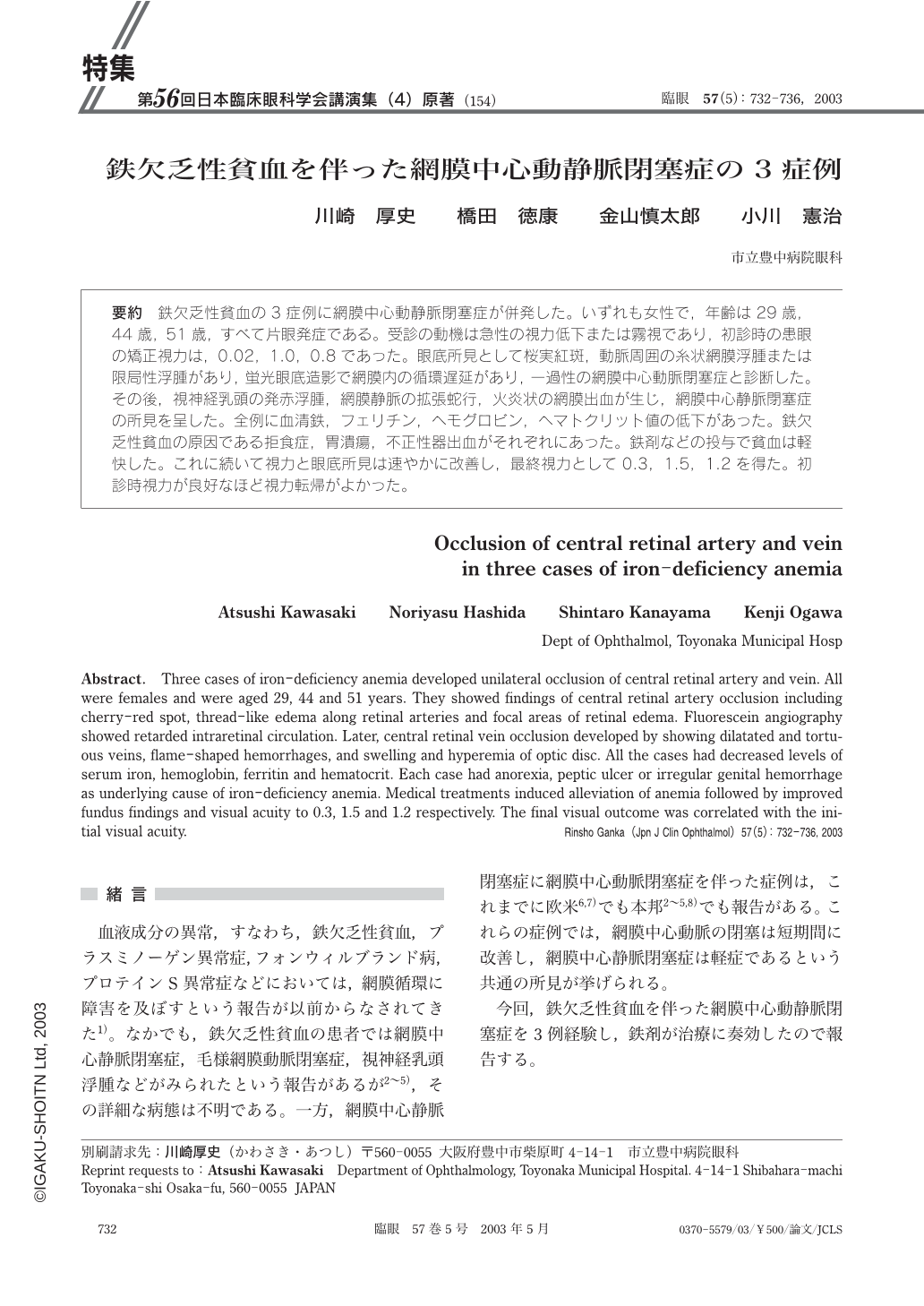2 0 0 0 鉄欠乏性貧血を伴った網膜中心動静脈閉塞症の3症例
- 著者
- 川崎 厚史 橋田 徳康 金山 慎太郎 小川 憲治
- 出版者
- 医学書院
- 雑誌
- 臨床眼科 (ISSN:03705579)
- 巻号頁・発行日
- vol.57, no.5, pp.732-736, 2003-05-15
要約 鉄欠乏性貧血の3症例に網膜中心動静脈閉塞症が併発した。いずれも女性で,年齢は29歳,44歳,51歳,すべて片眼発症である。受診の動機は急性の視力低下または霧視であり,初診時の患眼の矯正視力は,0.02,1.0,0.8であった。眼底所見として桜実紅斑,動脈周囲の糸状網膜浮腫または限局性浮腫があり,蛍光眼底造影で網膜内の循環遅延があり,一過性の網膜中心動脈閉塞症と診断した。その後,視神経乳頭の発赤浮腫,網膜静脈の拡張蛇行,火炎状の網膜出血が生じ,網膜中心静脈閉塞症の所見を呈した。全例に血清鉄,フェリチン,ヘモグロビン,ヘマトクリット値の低下があった。鉄欠乏性貧血の原因である拒食症,胃潰瘍,不正性器出血がそれぞれにあった。鉄剤などの投与で貧血は軽快した。これに続いて視力と眼底所見は速やかに改善し,最終視力として0.3,1.5,1.2を得た。初診時視力が良好なほど視力転帰がよかった。
1 0 0 0 OA 保険薬局の薬剤師を対象とした副作用救済制度についての意識調査およびその問題点の検討
- 著者
- 秋山 滋男 土井 信幸 淺野 未代子 福澄 重泰 高橋 真吾 鈴木 勝俊 小川 憲治 宮本 悦子
- 出版者
- 一般社団法人 日本医薬品情報学会
- 雑誌
- 医薬品情報学 (ISSN:13451464)
- 巻号頁・発行日
- vol.22, no.2, pp.101-107, 2020-08-31 (Released:2020-09-18)
- 参考文献数
- 9
Objectives: “Adverse Drug Reaction Relief System” (hereinafter called the Relief System) has been established to provide prompt relief to patients experiencing health damage caused by adverse drug reactions. Since 2018, the Relief System has required community pharmacies that acquire additional points as local support system to actively report adverse drug reactions. Here, we investigated the recognition and utilization of the relief system among community pharmacists.Method: A questionnaire survey was conducted among community pharmacists between August 1 and September 30, 2019.Results: The survey achieved a response rate of 58.1%. The recognition rates of the relief system and Pharmaceuticals and Medical Devices Agency (PMDA) as its application destination were 98.9 and 74.5%, respectively. Of the community pharmacists, 2.6% had experience in utilizing the relief system; and 8.8% did not want to recommend the utilization of the relief system for patients mainly because of the “low recognition of the system” and “the complicated and troublesome preparation of the necessary documents such as medical certificates.” The community pharmacists who acquire additional points as local support system, compared with those who do not, achieved significantly higher rates in two items, including that for preparation of the documented procedures pertaining to adverse drug reactions.Conclusion: Despite the high recognition of the relief system among community pharmacists, the percentage of pharmacists with experience in actually utilizing the relief system and applying to the PMDA was low. One reason that the use of the relief system was not widespread was the low recognition particularly of the destination and procedures of reports on adverse drug reactions. In the future, educational campaigns to improve pharmacists’ comprehension of the relief system will be needed. Moreover, pharmacists must play a central role in enhancing the recognition of the public relief system and promoting medical safety.
